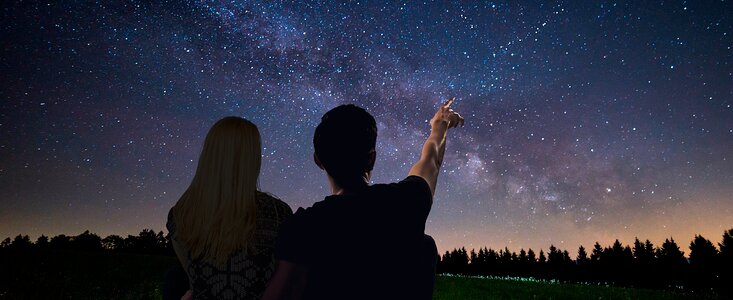¿Te apasionan las estrellas? Los astrónomos tienen una sugerencia especial para el Día de San Valentín
11 Febrero 2020
¿Hay algo más romántico que un cielo completamente estrellado? Actualmente en la Tierra existen cada vez menos lugares donde aún se puede disfrutar de un verdadero cielo oscuro repleto de estrellas. La contaminación lumínica pone en riesgo uno de los espectáculos más románticos de la naturaleza, por esta razón, en este Día de San Valentín, los astrónomos le piden al público que les ayuden a demostrar su amor por las estrellas haciendo observaciones de contaminación lumínica como parte del programa Globe at Night.
Por miles de años, el cielo nocturno ha sido fuente de inspiración para el romance, el asombro y el arte, pero actualmente corremos el riesgo de eclipsar la belleza de las estrellas. A pesar que las personas se están volviendo más conscientes de la importancia de los cielos oscuros, los cambios en la tecnología amenazan el misterio de una noche estrellada.
Mientras las luces LED van reemplazando cada vez más las antiguas tecnologías que iluminan nuestras calles, jardines y espacios públicos, los astrónomos se preguntan si el resultado es tener cielos nocturnos con más brillo o más oscuros. Si bien medir el brillo del cielo en observatorios aislados es parte del trabajo nocturno de los astrónomos, saber qué sucede en los vecindarios de todo el mundo resulta una tarea mucho más difícil, por lo que están recurriendo al público para conseguir ayuda.
En este Día de San Valentín, los astrónomos están pidiéndole a las personas que se involucren en el proyecto “Globe at Night” coordinado por la astrónoma Dra. Constance Walker del Laboratorio Nacional de Investigación en Astronomía Óptica e Infrarroja de la Fundación Nacional de Ciencias de Estados Unidos.
“La contaminación lumínica nos dificulta ver las estrellas. Esto significa que, si usted nos dice cuántas estrellas puede ver, nosotros podemos estimar cuánto brillo hay en su cielo”, menciona Walker. El proyecto pide a los participantes que miren al cielo y luego elijan de los sets de 8 mapas de estrellas, cuál es el que se acerca mejor a lo que observan. “El proyecto no requiere conocimiento detallado sobre constelaciones o astronomía”, explica Walker. “Siempre que puedas localizar la constelación de Orión, ¡puedes ser parte de él!”.
Este año, la campaña Globe at Night de Febrero comenzará justo en el Día de San Valentín. “Chile cuenta con un cielo privilegiado para la observación del cielo nocturno, y qué manera más inspiradora de proteger este patrimonio natural de la Humanidad de la contaminación lumínica es sumarnos a esta campaña mundial en el día de los enamorados,” señala el Director del Observatorio de AURA en Chile, Dr. Mario Hamuy. Pero incluso si su noche del 14 de Febrero estuviera nublada, habrán muchas otras oportunidades para participar. Las campañas de este año 2020, utilizando la constelación de Orión, también se mantendrán desde el 14-23 de febrero y el 14-24 de marzo. Durante el resto del año, las oportunidades para participar utilizando otras constelaciones se pueden encontrar en el sitio web del proyecto [1]. Durante cualquiera de las campañas de 10 días de cada mes, las mediciones se pueden enviar a la página de reportes llamada webapp.
Mientras parece sorprendente que los astrónomos pidan observaciones al público general, la ciencia ciudadana puede llevar a reales descubrimientos. Un artículo publicado en la revista Nature Astronomy en el 2018 indicó que, cuando se trata de descubrir si el cielo se está volviendo más brillante o más oscuro alrededor del mundo, “las observaciones a simple vista son fundamentales”. Así como la belleza del cielo puede ser el deleite de cualquiera, así también cualquier persona en cualquier lugar puede ayudar a conservar los fascinantes cielos estrellados. Para enfatizar la importancia de conservar cielos estrellados y cómo puede Globe at Night ayudar en dicha tarea, tenemos dos videos disponibles: oir2005a y oir2005b.
El proyecto Globe at Night necesita todas las mediciones posibles para contar con un panorama global del estado de nuestros cielos oscuros. Entonces, si usted tiene química con su cita en este Día de San Valentín, ¿por qué no añadirle un poco de astronomía también?
Notas
[1] Considerando que la luz de la luna y la contaminación lumínica iluminan el cielo nocturno, sólo se pueden hacer observaciones cuando la Luna no está iluminando el cielo.
Más Información
NOIRLab de NSF (Laboratorio Nacional de Investigación en Astronomía Óptica-Infrarroja de NSF), el centro de EE. UU. para la astronomía óptica-infrarroja en tierra, opera el Observatorio internacional Gemini (una instalación de NSF, NRC–Canada, ANID–Chile, MCTIC–Brasil, MINCyT–Argentina y KASI – República de Corea), el Observatorio Nacional Kitt Peak (KPNO), el Observatorio Interamericano Cerro Tololo (CTIO), el Centro de Datos para la Comunidad Científica (CSDC) y el Observatorio Vera C. Rubin (en cooperación con SLAC National Accelerator Laboratory del DOE). Está administrado por la Asociación de Universidades para la Investigación en Astronomía (AURA) en virtud de un acuerdo de cooperación con NSF y tiene su sede en Tucson, Arizona. La comunidad astronómica tiene el honor de tener la oportunidad de realizar investigaciones astronómicas en Iolkam Du’ag (Kitt Peak) en Arizona, en Maunakea, en Hawai, y en Cerro Tololo y Cerro Pachón en Chile. Reconocemos y apreciamos el importante rol cultural y la veneración que estos sitios tienen para la Nación Tohono O’odham, para la comunidad nativa de Hawai y para las comunidades locales en Chile, respectivamente.
Enlaces
Contactos
Constance Walker
Laboratorio Nacional de Investigación para la Astronomía Óptica-Infrarroja de la NSF
Tucson, USA
Cel: +1-520-318-8535
Correo electrónico: cwalker@noao.edu
Christopher Kyba
GFZ German Research Centre for Geosciences
Potsdam, Germany
Cel: +49 331 288 28973
Correo electrónico: kyba@gfz-potsdam.de
Constance Walker
NSF’s National Optical-Infrared Astronomy Research Laboratory
Tucson, USA
Cel: +1-520-318-8535
Correo electrónico: cwalker@noao.edu
Christopher Kyba
GFZ German Research Centre for Geosciences
Potsdam, Germany
Cel: +49 331 288 28973
Correo electrónico: kyba@gfz-potsdam.de








